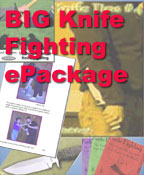With the U.S. being now awake to acts of terrorism, there is a desire for martial artists to start practicing knife defense techniques.
Understandable.
The question is, which techniques are more likely to get you out of a knife encounter alive, and which are deceptively dangerous?
Sean Madigan of BIGJKD.com suggests practicing your knife techniques with a color marker (water soluble). If you do your technique, and end up with marks on you from the attacker's marker, then in real life you would have been cut.
I coat my practice knife (rubber, wooden, etc.) with chalk dust -- I used to be a teacher. I think this adds realism, because you can coat both edges of the knife. So, you can get 'sliced' in practice, rather than just 'poked' with he end of a marker.
Either way works.
So, let's apply this to a standard knife-defense move. By the way, I think this is one of the worst reactions you could have to a downward stroke of a knife. You'll soon see why.
Your attacker has a knife. He (or she) is holding it with the blade pointing down, extending through the bottom of the closed fist.
He stabs down toward your head, from above.
A standard reaction is to block with both hands. The good guy (or gal) crosses the hands a bit above the wrists and blocks upward, catching the knife-stabbing hand in the "V" formed by your wrists.
So, what's wrong with that?
Don't get me wrong. The theory is good. I do approve of taking a knife to the side. It's just how you get there that concerns me. And be careful -- getting the knife to the side, doesn't mean you are safe. The knife could still come up and bite you from a different direction.
So, if you accidentally find yourself blocking up, what do you do?
Above all -- experiment. Much better to get a chalk line on you now, than cut later.
 Start with 10 Days to Better Knife Fighting and add over a dozen more knife fighting ebooks and ebooklets.
Make your knife fighting responses much more complete, and definitely automatic with these ebooks. Each covers a practical aspect of knife fighting -- knife against knife.
Don't leave home without these skills.
Start with 10 Days to Better Knife Fighting and add over a dozen more knife fighting ebooks and ebooklets.
Make your knife fighting responses much more complete, and definitely automatic with these ebooks. Each covers a practical aspect of knife fighting -- knife against knife.
Don't leave home without these skills.
FREE
Martial Arts
Mastery
Weekly ezine